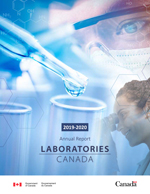ISSN 2563-7150
Catalogue number: P1-41E-PDF
PDF version
2019-2020 Laboratories Canada Annual Report
3.4
MB
, 54 pages
Table of Contents
Assistant Deputy Ministers’ Message
Hello,
We are pleased to present the Laboratories Canada Annual Report for 2019-2020.
Laboratories Canada was given the ambitious mandate to work with federal scientists and researchers to create together a national network of modern, multipurpose, scientific infrastructure. Our goal is to further the federal scientific community’s engagement in world-class, multidisciplinary research and innovation.
A significant $2.8 billion investment announced in Budget 2018 launched the first phase of the Laboratories Canada strategy, allowing Public Services and Procurement Canada (PSPC) to lay the groundwork for concrete action. Laboratories Canada will foster and strengthen partnerships across the federal science community, thereby strengthening the national science and technology ecosystem.
Federal science and technology research is an essential function in government. Not only does it support the Government’s commitment to ensure the health, safety and security of Canadians, it also plays a critical role in supporting Canada’s economic agenda, by fostering innovation and creating jobs. From coast to coast to coast, federal scientists perform cutting-edge work that makes a real difference in the lives of Canadians. Whether it’s countering emerging diseases and pandemics, combating climate change, ensuring animal health or transportation safety, the expertise of federal scientists is as broad as it is essential.
Our intent with this initial report is to underscore the pillars of the Long Term Vision and Plan for Laboratories Canada and highlight key milestones achieved in 2019-20.
To successfully advance science excellence, Laboratories Canada’s vision is bolstered by four pillars: Facilities; Barriers; Information Management and Information Technology (IM/IT); and Equipment. These pillars will drive the strategy to facilitate collaboration, reduce barriers, and provide the necessary infrastructure, equipment and information technology federal scientists need to carry out the important work they do on behalf of Canadians.
As part of its vision, Laboratories Canada is:
- Creating a framework for collaboration that will support the federal science community and the next generation of scientists;
- Developing infrastructure and greater access to common tools to enable leading-edge science; and
- Leveraging partnerships with Indigenous people and organizations, academia, industry, and other key players in research and innovation.
This vision is bold and transformative, and the strength of the strategy is its integrated approach. The success of Laboratories Canada and community in achieving it hinges on our meaningful and committed partnerships. In collaboration with our partners, we will design and deliver modern and sustainable federal laboratories that amplify existing successful collaborative efforts. The program will enhance relationships across the federal science community to realize the benefits of multidisciplinary research.
Laboratories Canada partners are committed to building a stronger, well-connected federal science and technology ecosystem, through amplified interdisciplinary work and facilities built for collaboration. This initiative represents a significant opportunity to create positive and lasting change, to better support and enable federal science now and into the future.
Sincerely,

Rob Wright
Assistant Deputy
Minister

Duncan Retson
Associate Assistant
Deputy Minister
The Laboratories Canada Long-Term Vision and Plan (LTVP)
The Government’s Commitment to Science Renewal
Federal science and technology (S&T) research plays a key role in Canadian society and is essential to achieving the Government of Canada’s mandate of supporting the health, security and well-being of Canadians and advancing Canada’s economic agenda. Research by federal scientists is critical to solving the increasingly complex issues facing Canada: countering emerging diseases and pandemics, combating climate change while developing our natural resources, and addressing the growing risks of cyber security. Federal science helps Canada better manage risks and apply fundamental research practically to create jobs, stimulate innovation and foster economic growth. Continued and enhanced science excellence requires that current and future generations of federal scientists have the tools they need to perform leading-edge science. However, much of our federal science infrastructure requires modernization in order to keep pace with the global science innovation. Scientific equipment is often outdated, and institutional barriers means it is inefficiently utilized. IT systems and networks cannot support big data analytics, critical in twenty-first century science. Many of the core facilities themselves, dating to the immediate post-war years, are in critical condition.
Federal scientists also need to be able to collaborate with academic, industrial, Indigenous, and international partners and keep pace with transformative changes shaping the science landscape. Enhancing existing and enabling new collaborations—by bringing researchers together both physically and virtually—will accelerate the breakthroughs and discoveries that will ultimately benefit Canadians.
Budget 2017 committed to developing a federal S&T infrastructure strategy to define a more integrated, effective approach to federal laboratories, to ensure that “federal scientists have access to the world-class infrastructure, innovative equipment and computer networks they need to produce the best results for Canadians”. Budget 2017 also provided $80 million, to replace the Sidney Centre for Plant Health, and launched a Horizontal Fixed Asset Review (FAR) to “identify ways to enhance or generate greater value from government assets.”
Budget 2018 launched the first phase of a transformative approach to federal S&T by providing a historic investment of $2.8 billion over 5 years to build world-class, collaborative, modern and accessible facilities, to support the renewal of federal laboratories.
“Rather than working in silos, this new approach to federal science and discovery will look to bring together federal scientists and science facilities across government… in order to advance interdisciplinary research on, among other things, climate change, ocean protection, and human health.”
- Budget 2018
Laboratories Canada is a 25-year strategy that is part of the Government of Canada’s plan to strengthen federal science in Canada. This strategy aims to provide federal scientists with leading-edge facilities, modernized information management and information technology (IM/ IT) systems, greater access to common tools and reduced barriers to science and technology (S&T) that facilitate collaboration and allows them to continue the important work they do on behalf of Canadians.
The strategy will cross departmental mandates to realize the benefits of multidisciplinary, collaborative, cutting-edge S&T. Rather than take a big bang approach, Laboratories Canada will leverage lessons learned from recent enterprise-wide initiatives. A deliberate and phased approach is being taken in implementing the strategy to ensure it is open, collaborative and interdisciplinary, aligned with the vision for federal science set out by the Chief Science Advisor in her 2018-19 annual report:
“If Canada is to succeed in making strategic investments to advance the place of Canadian science and scientists in the world, it is essential that organizational leadership move further in overcoming structural barriers and business-as-usual models to achieve coherence, and that they be supported in bringing about the changes needed to position Canada and its research enterprise for success in the coming decades.”
Over time, this ambitious strategy will transform and strengthen Canada’s national S&T ecosystem, as collaborative, accessible, “green” federal S&T facilities provide federal scientists with the tools information management and information technology (IM/IT), and scientific equipment) they need to support collaborations and evidence-based decision making, and increase the government’s ability to attract, retain and mobilize world-class talent. S&T collaboration will advance the pace of discovery and enhance the Government’s ability to address complex, multidisciplinary issues. It will drive a culture shift from “siloed” science-based departments and agencies (SBDA) to a more strategic, enterprise approach.
“This undertaking… increasingly relies on collaborations that cut across departmental, sectoral, and disciplinary boundaries. Infrastructure, however, is only one component of a science ecosystem — people are the heart of a successful, collaborative S&T ecosystem.”
- Building Excellence: The Expert Panel on Leading Practices for Transforming Canadian Science Through Infrastructure
The scope of the transformation will require change management for both employees and organizations. Laboratories Canada will employ a phased approach using early wins to build Canadians’ trust, using experimentation with both service providers and practitioners to understand S&T community needs, leadership to manage new ideas and approaches to conducting science, and developing and delivering new tools to help transition. Engagement of the S&T community will also provide insight and support decision making, future planning, and will evolve to reflect best practices and lessons learned throughout the strategy.
The Long-Term Vision and Plan (LTVP)
Laboratories Canada is guided by a Long Term Vision and Plan (LTVP) that describes an integrated approach to building a network of new federal laboratories and fostering the change necessary to amplify existing successful collaborative efforts.
The LTVP aligns with the Government of Canada new Vision for Science and Research, which describes federal S&T as a key pillar of Canada’s S&T and innovation ecosystem. This ambitious approach builds collaboration across departmental mandates to realize the benefits of multidisciplinary, collaborative, cutting-edge S&T.
Collaboration represents a key component of this approach and leverages the capacity of all actors across the S&T ecosystem, including federal and provincial laboratories, academic institutions, Indigenous knowledge, and industry both nationally and internationally. Working together can amplify the impact of equipment and facility assets, share expertise and transfer knowledge in support of open science principles, and gain access to highly qualified personnel and training opportunities.
“Being able to collaborate with our federal science colleagues as well as academic partners will not only enable us to tackle new problems, but we will be able to amplify the impact of the science we already have.”
- Federal scientist
Vision
Create a world-class national network of science infrastructure, comprised of modern, multipurpose, federal S&T laboratories to support collaborative, multidisciplinary research and innovation, and evidence-based decision-making, including in regulatory responsibilities.
Given the scope of the federal science infrastructure portfolio, Laboratories Canada has a 25-year horizon to modernize facilities across the country. Initial efforts will focus on addressing federal facilities identified as being in the most critical condition. As work progresses toward achieving the LTVP, six principles will guide the strategy.
The LTVP Guiding Principles:
- Science Excellence: Renewed federal laboratories will support top talent in delivering high-impact science that informs decision making and addresses the challenges of today and tomorrow.
- Collaboration: Designed and equipped as collaborative hubs, renewed laboratories will bring together scientists and foster a culture of openness and engagement with new partners and stakeholders.
- Inclusive & Diverse Talent Pool: Modern and collaborative spaces will help attract and retain high-calibre, diverse scientists, including early-career and international researchers.
- Agility and Responsiveness: Flexible, adaptable space will ensure that scientists can respond quickly to shifting priorities, new scientific discoveries, and stay at the cutting edge of their fields.
- Environmental Responsibility: Environmentally sustainable facilities will be climate resilient and carbon neutral, supporting government commitments on climate change and green operations.
- Public Stewardship: Prudently managed science and technology (S&T) assets will result in fit-for-purpose facilities that maximize space, reduce redundancy, and optimize investments.
Laboratories Canada is guided by a LTVP similar to the Parliamentary Precinct LTVP which has guided the complex rehabilitation work on the Parliamentary Precinct over the past 15 years. The LTVP for the Parliamentary precinct leveraged rolling programs of work that enabled the successful transition of parliamentary operations to the newly rehabilitated West Block and the Senate of Canada Building to launch the historic rehabilitation of the Centre Block currently underway.
Figure 1: Diagrammatic representation of Laboratories Canada Long Term Vision and Plan.
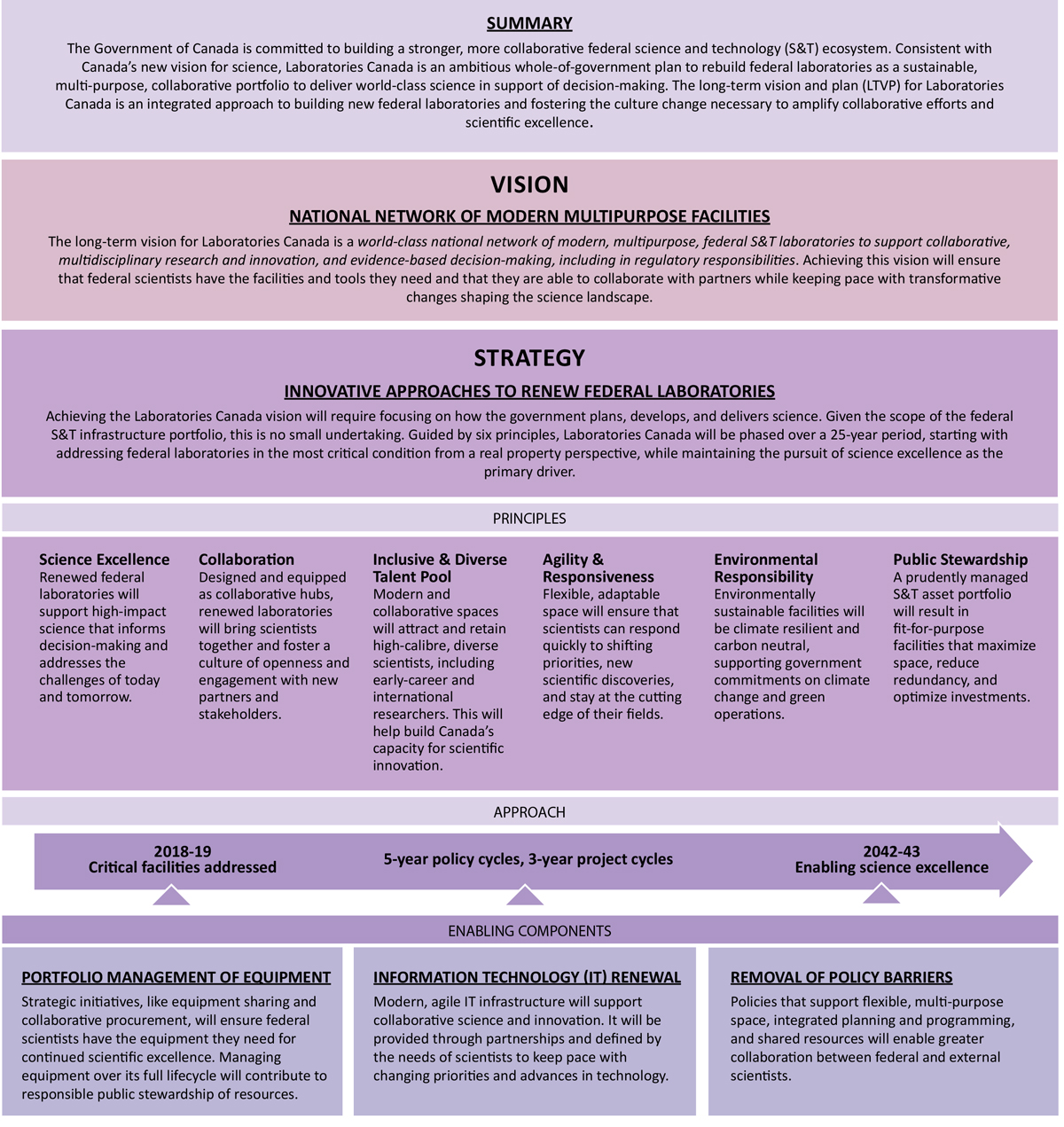
The Four Pillars
Advancing science excellence will be the core and primary driver of the Laboratories Canada strategy. This includes meeting the needs of the science community, as well as delivering on the government’s commitment to provide real and meaningful results for Canadians.
The LTVP represents a new directive for science assets and the first phase of this approach includes integrated strategies on science equipment, IM/IT and addressing barriers to collaboration to ensure the most effective use of the new science facilities. These represent the 4 pillars that will help guide this strategy and will facilitate collaborations that enhance science excellence, enabling federal scientists to continue the important work they do on behalf of Canadians.
The Four Pillars
- Facilities - Laboratories Canada investments will replace ailing critical science infrastructure, to build leading-edge collaborative, accessible, and sustainable facilities.
- Barriers - A number of factors that inhibit collaboration between federal scientists and external partners have been identified in recent years and Laboratories Canada is taking steps to reducing barriers to S&T.
- IM/IT - Laboratories Canada in close collaboration with Shared Services Canada (SSC), will develop a comprehensive strategy to balance the need for modern, agile IM/IT infrastructure to support science collaboration, while securing core federal IM/IT systems from cyber threats. The strategy will include partnerships from SSC and IM/IT service providers, from both the public and private sectors as appropriate.
- Equipment - Laboratories Canada will develop a whole-of-government approach to sharing, managing, and procuring scientific equipment to provide scientists the tools they need to support collaboration and evidence based decision-making and increase the government’s ability to attract, retain, and mobilize world-class talent.
Figure 2: Diagrammatic representation of Laboratories Canada four strategic pillars.
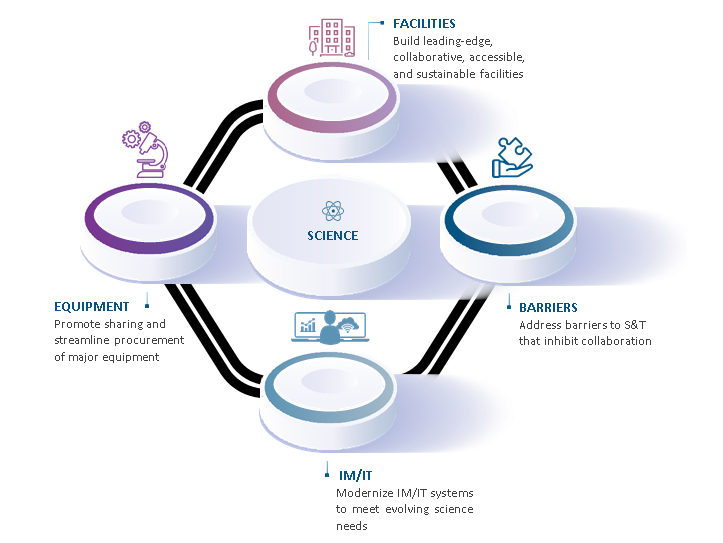
Phase 1
Phase 1 will focus on science facilities that have been identified as being in critical condition and at risk of long-term failure impacting science delivery in areas key to Canadians. Phase 1 projects will also see the mitigation of barriers to S&T that inhibit collaboration and advances with respect to IM/IT for scientific purposes.
Recognizing the importance of collaboration, Laboratories Canada is bringing together 14 SBDAs based on their common science goals. These groups are now exploring opportunities to further strengthen their research agendas through enhanced interdisciplinary work and shared facilities where appropriate.
Science departments and agencies have come together to identify complimentary outcomes that are the basis for Phase 1 infrastructure projects. Together, these groups are now exploring opportunities to strengthen their research agendas through enhanced interdisciplinary work and shared facilities where appropriate.
The Phase 1 activities have been grouped into hubs, based on science program synergies:
- Atlantic Science Enterprise Centre (ASEC) hub will undertake science focused on improving sustainability of Atlantic fresh and saltwater resources, and monitoring and protecting the health of coastal ecosystems of the Gulf St. Lawrence/Atlantic Ocean regions.
- Cultural Heritage Science (CHS) hub will undertake improving the science of preserving cultural heritage for future generations, facilitating access to collections, as well as identifying and addressing emerging risks to cultural heritage.
- Regulatory and Security Science (RSS) hub will provide seamless integration of complementary government science capabilities to protect Canada’s people, animals, and plants, as well as advance innovation and economic growth.
- TerraCanada science hub will undertake science that is focused on advancing the economic potential of Canadian lands and resources in a sustainable manner. The TerraCanada science hub will lead the transition to a low carbon economy by meeting emission reduction targets and will generate and share knowledge to mitigate future impacts and protect Canadians from human-made and natural hazards.
- Transportation Safety and Technology Science (TSTS) hub will undertake assessing and reducing transportation safety risks for Canadians; creating new technologies to improve safety certification processes, responsive and accurate investigation procedures as well as enhancing transportation safety.
Regional Excellence
Plans are being developed that capture and reinforce regional science excellence within the national science ecosystem. Opportunities to catalyze collaboration by optimizing and sharing laboratory facilities or co-locating SBDAs and external partners that conduct similar activities will be pursued in order to realize tangible synergies in program delivery. This approach will leverage existing regional expertise not found elsewhere, support the science needed to address horizontal issues that implicate multiple departmental mandates and result in a “leaner” real property portfolio.
Figure 3: Diagrammatic representation of the 5 science hubs under Phase 1 of Laboratories Canada with their respective priorities.
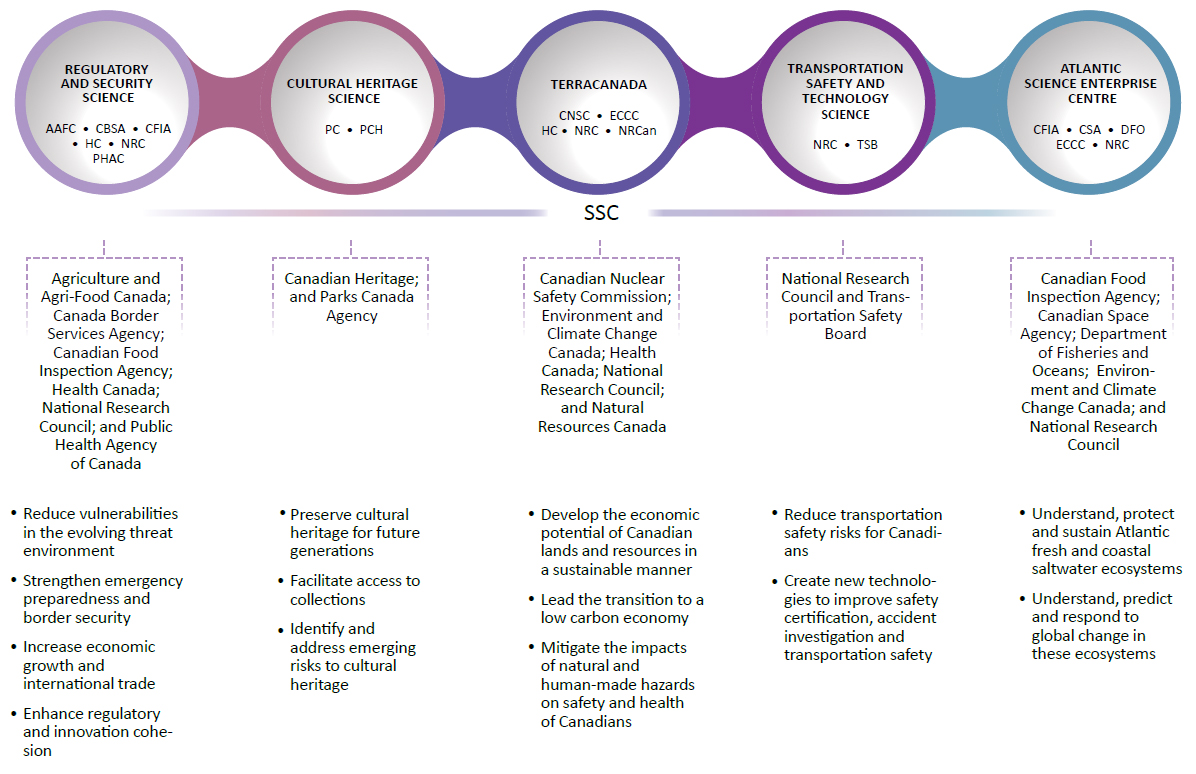
The Laboratories Canada Office (LCO)
Laboratories Canada is a partnership between the Minister of Innovation, Science and Industry (ISI) and the Minister of Public Services and Procurement (PSP), in collaboration with SBDAs. ISI leads on the overall science policy government-wide, and PSPC leads on the implementation of this strategy, specifically:
- Transforming Canadian science through the design, construction/rehabilitation of the science infrastructure.
- Development of the governance structure that supports horizontal and vertical accountability, decision-making, and provides appropriate oversight.
The Laboratories Canada Office (LCO), housed within PSPC, is leading the integrated effort across government to deliver this strategy. They are working in partnership with federal departments and agencies as well as external stakeholders.
SSC and Laboratories Canada collaborate closely in the delivery of IM/IT along with the governance and project management of the projects. SSC works closely with the LCO as well as key federal science and technology stakeholders to ensure modern IM/IT systems are in place to meet the evolving needs of science.
Science departments and agencies continue to lead the science within their mandates and work within their hubs to encourage and develop collaborative science to improve Canadian science outcomes.
Figure 4: Diagrammatic representation of the Laboratories Canada governance ecosystem.
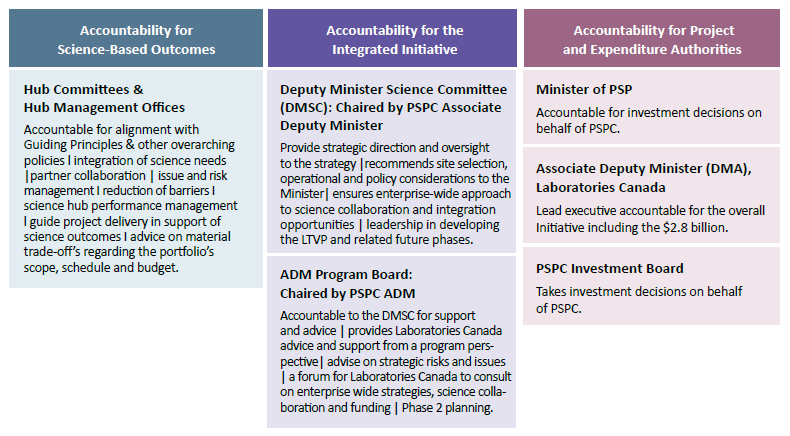
Figure 5: Diagrammatic representation illustrating the collaborative partnership between PSPC and SBDAs to deliver the Laboratories Canada LTVP.
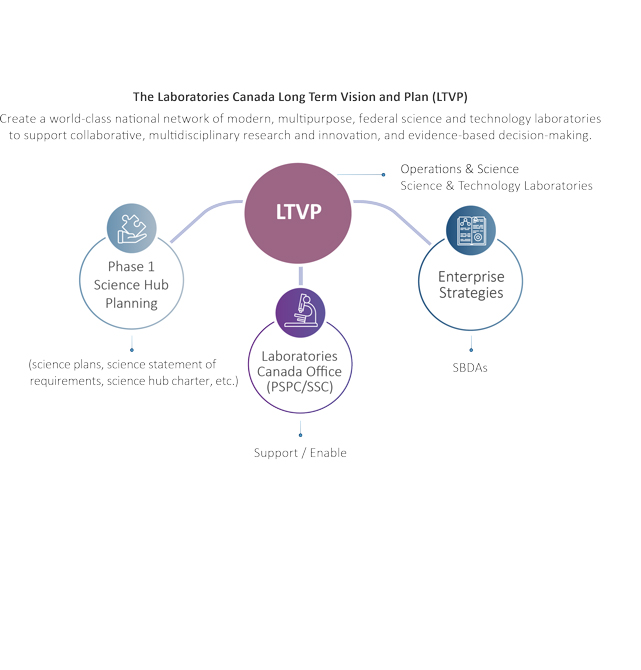
Understanding and Managing the Risks of Transformation
Laboratories Canada will act as a catalyst for transformative change in the federal science ecosystem: bringing departments and agencies together to collaborate on cross-cutting priorities; working in partnership with the federal science community to inform the strategy and infrastructure projects; and using horizontal governance to drive decision making and uphold accountabilities for policy/infrastructure and science outcomes.
Risks and challenges are an inherent part of a transformative initiative of this scope and scale, and PSPC will continue to work hand in hand with the Phase 1 partners to ensure the strategy delivers on its mandate with tangible benefits to Canada and Canadians.
The primary challenges stem from the complexity of a horizontal initiative involving so many federal partners; multiple simultaneous projects with potentially-evolving stakeholder requirements as Canada’s science landscape changes; delivering on ambitious timelines; and maintaining affordability and prioritizing within available funding.
Effective horizontal governance is a key enabler for the Laboratories Canada strategy, and standing it up is a challenging and nuanced undertaking, critical to ensuring informed, collaborative direction and decisions needed to advance the program and projects. The Laboratories Canada Office is working with the partners to apply lessons learned and refine the current governance structure, clarifying accountabilities with respect to strategy objectives and the investment, and streamlining decision making as we move towards project implementation to mitigate any risks to timely guidance required for program and project advancement.
The Laboratories Canada Office is working with 15 partner departments and agencies to advance the first phase program of work under the Long Term Vision and Plan. These partners have come together through plans they have created to perform interdisciplinary science, and are still working through how this collaboration will be realized and how the science outcomes will be achieved.
In parallel, the Laboratories Canada Office is leading planning and design work for the infrastructure projects, while also developing enabling strategies for scientific equipment, IM/IT, and custodianship of the future facilities, which adds complexity to project implementation. Another complexity is the impact the COVID-19 pandemic may have on Government of Canada science priorities in the coming years. It is an immediate and pressing priority, but it also could prompt longer-term changes to the needs of science partners with facility project that are in-flight. These complexities may have downstream impacts on that could place pressure on project budgets and implementation timelines, and on the overall delivery timing and funding envelope for the current phase program of work.
The strategy has benefited from professional expertise in laboratory design and costing to refine key assumptions and further define requirements that were underestimated at the outset of the initiative. These lessons learned will be applied to inform development of future phase programs of work.
Enabling federal scientists with modern, leading edge scientific equipment and IM/IT tools will be essential to achieving science outcomes; however, additional resources may be required to ensure science partners have this capacity. This remains a risk that the Laboratories Canada Office is tracking closely, which could influence the overall success of the strategy.
Custodianship and operating models for the future collaborative, multi-tenant facilities is another area where Laboratories Canada is working to develop guiding frameworks in concert with the federal science community and Central Agencies. The Long Term Vision and Plan identifies responsible public stewardship as a guiding principle, which aligns with the Treasury Board of Canada Secretariat Fixed Asset Review that has provided guidance on moving towards strategic portfolio management of the science asset class. This represents a major shift in the approach across science-based departments and agencies, most of whom manage their individual portfolios as custodians and have had to balance investing in science programs with sustaining their facilities. Forecasting the operating costs associated with the future facilities is a challenge at this early stage in project development, and is an area for risk management by the partners who will assume these costs to sustain their new facilities.
Key to addressing these challenges for Laboratories Canada is strong collaboration between partner departments and agencies, proactive change management, capacity-building within the program, and robust project/contract management practices. Also key is a pioneering engagement with the Chief Audit Executive (CAE) community. As a complex horizontal initiative, CAEs from implicated departments and agencies, are actively engaged with Laboratories Canada to provide upfront assurance of program structures and plans and approaches, rather than the conventional approach of studying or assessing weaknesses after the fact. This ongoing, real-time focus on managing the risks for PSPC as implementer, but also of the whole community as partners whose effective collaboration will determine how well we collectively realize the foundational science goals, brings an uncommon and high-value perspective to all involved.
Laboratories Canada Progress to Date
PSPC in partnership with the SBDAs has fully advanced the Laboratories Canada strategy and made foundational advancements across all pillars of this transformative horizontal strategy.
Science Plans and Science Statement of Requirements
Each of the 5 science hubs have collaborated to prepare comprehensive science plans based on science synergies. The hub science plans will ensure science drives the enabling infrastructure of Laboratories Canada. The science plans play a central role in designing new facilities and serve as foundational documents to outline current and future science hub visions that will ultimately benefit all Canadians. The plans are a key prerequisite to defining the Science Statements of Requirements (SSORs) and Functional Programming, both of which inform facility design. In 2019, science hubs in partnership with the Laboratories Canada Office completed science plans, and science statement of requirements for all 5 science hubs.
Functional Programming
Through Laboratories Canada, new federal science and research facilities will be designed with science and collaboration at the forefront to facilitate interdisciplinary science with modern, accessible, multipurpose spaces to host partners.
A modern collaborative, user-centered facility puts a greater emphasis on the functional needs and work styles of federal scientists to create an environment that caters to their unique activities and processes, offers individual choice and flexibility. This will be achieved through a detailed functional programming process involving Framework, a joint venture company between Stantec, Merrick and Dialog, for laboratory design services.
Figure 6: Diagrammatic representation of the progress to date.

Functional programming is the first step in the design process that translates science hubs’ science requirements into space requirements, which is the foundation for the schematic design of the new facilities.
Functional programming for the new facilities will be the result of a planning and consultation process to identify both the functional and general needs of the facility users, collaboration in order to create spaces that are conducive to innovation and creativity. Client-specific information such as detailed special purpose space specifications, may also inform the functional programming process, etc. This foundational step can take anywhere from eight to eighteen months to complete depending on the hub size, complexity and capacity and is already underway for the ASEC, CHS and TSTS science hubs. This process involves extensive collaboration with the science hubs, which included over 30 functional programming workshops held in the last year, involving more than 200 participants.
Repeatable Laboratories Design Framework
In parallel with progress on functional programming, Laboratories Canada has commenced the foundational design work known as Repeatable Laboratories Design Framework. Repeatable Laboratories Design Framework is being established as a compendium of laboratory standards, design guidelines, best practices, benchmarking and repeatable laboratory typologies, including base-building standards.
This design framework will help to ensure consistency and quality assurance across projects to ensure high quality outcomes and will inform planning, design, and implementation of all Laboratories Canada projects. It will provide a roadmap for all design and construction firms to achieve consistent design and life cycle operational objectives, for example, sustainability, architecture, structural, and accessibility.
Lessons Learned – Collaboration by Design
Site visits conducted by Laboratories Canada identified key lessons learned for collaborative design. Specifically how collaborative design and the creation of adaptable collaborative spaces are leveraged to design laboratories that successfully integrate multidisciplinary / transdisciplinary functions to ensure that collaboration is an integral element in achieving science outcomes.
In early 2020, delegations from Laboratories Canada traveled to Europe (Brussels, in Belgium, and cities in the United Kingdom including Manchester, Pirbright, London, and Norwich) to tour world-class laboratory facilities. The knowledge obtained from visits to state-of-the-art facilities is being leveraged by Laboratories Canada and the science hubs to identify best practices in collaborative design and management and operations.
Facilities
While the LTVP identified geographic locations, a comprehensive process was developed in collaboration with science hubs to determine specific sites for the new laboratories in the National Capital. The process involves 5 continuous key steps:
- Identify Supply of Sites
- Science Needs Analysis
- Evaluation
- Feasibility
- Final Recommendations and Decision
Regional sites were assessed through a streamlined version of this process, which focused on leveraging existing partnerships with universities in the regions.
To further identify the most suitable site locations for new facilities in Phase 1, a comprehensive site selection methodology was developed in collaboration with the science hubs in 2019. The site selection evaluation criteria included a variety of science, real property and socio-economic considerations as well as additional quantitative and qualitative considerations as necessary, such as:
- Science — Site utility services, security and safety, environmental and geographic requirements and proximity considerations
- Real property — Zoning, site size and scalability for future expansion, utility services, geotechnical characteristics and environmental assessment
- Socio-economic — Sustainability and carbon neutral readiness, public perception, employee experience, heritage conservation considerations and consultations with municipalities and other local organizations
- Quantitative and qualitative considerations — Potential development costs, contaminated site remediation costs, transportation accessibility for employees, access to amenities, etc.
This evidence-based process serves to identify the most suitable sites, keeping science and scientists as primary drivers for decision making.
Figure 7: Diagrammatic representation of the site selection process as of March 31, 2020.
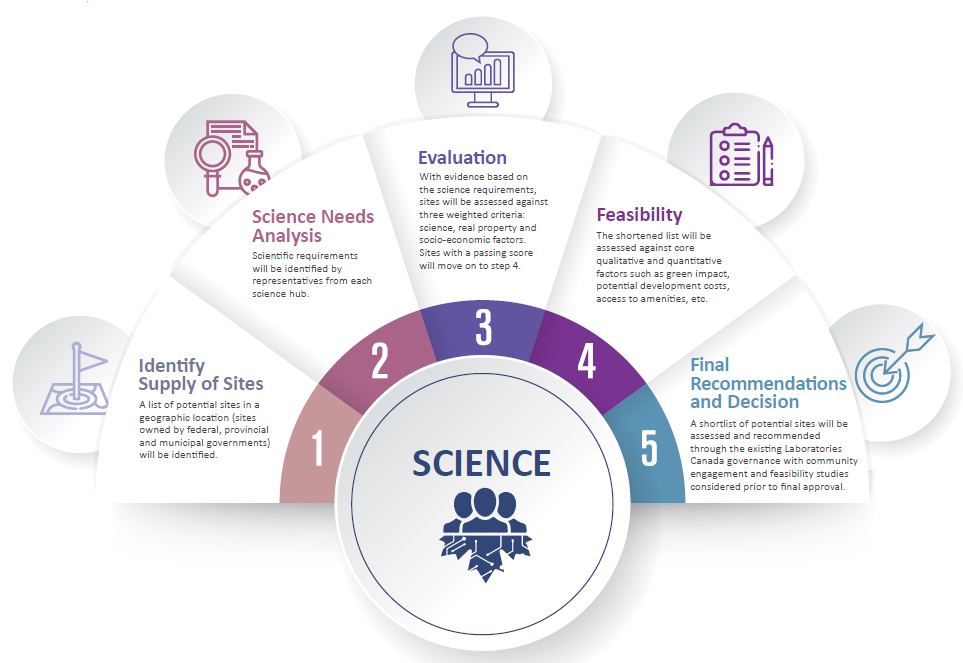
The ASEC’s Moncton facility is an example of a site that was selected prior to the Laboratories Canada strategy, but which aligned with the guiding principles and vision for Phase 1. The ASEC is located in Moncton, NB on the current site of Department of Fisheries and Oceans’ (DFO) Gulf Fisheries Centre, and co-located adjacent to DFO’s Gulf Region Headquarters. The Gulf Fisheries Centre building will be renovated as it is a heritage site with a long local history in education. This ASEC site was chosen as it is centrally located to the federal partners’ current locations and easily accessible to potential collaborators.
Additionally, TerraCanada science hub will develop and expand existing facilities in both Mississauga and Hamilton, ON locations to integrate National Research Council (NRC) of Canada and Natural Resources Canada (NRCan) capabilities with various academic, other government departments and industry partners. NRCan-Hamilton is an existing building while NRC-Mississauga is currently under construction and represents a new presence in the region.
Key milestones achieved include:
- Shortlist of National Capital Area (NCA) locations endorsed by science hub governance and the DMSC
- Enhanced feasibility analysis conducted on the National Capital Area (NCA) and regional locations
- Recommended sites and back-up sites advanced for all Hubs in the National Capital Area (NCA) and regional locations
Amplifying Partnerships
Laboratories Canada will leverage existing federal presence and academic/ industry partnerships to further science innovation and collaboration. Horizontal synergies between government, industry and academia will provide Laboratories Canada government researchers with real world insights and expand the value and relevance of federal science. This builds towards making federal science more agile and responsive to priorities. The regional sites selected for Phase 1 will act as catalysts of knowledge development and exchanges critical to fostering science innovation and regional economic growth. Co-locating the Phase 1 science facilities with academia and in close proximity to industry provides access to a pool of highly qualified talent and resources and opportunities to leverage academic research facilities.
Portfolio Framework
Laboratories Canada is mandated to develop a portfolio strategy. The following key foundational elements of a portfolio strategy have been advanced:
- Identified major assets, and developed the data layers needed to inform a strategy (e.g., condition, functionality, utilization)
- Standardized assessment of building condition and functionality for science assets to enable useful aggregation of information critical to establishing a portfolio perspective
- Given critical risks in some existing assets, a series of facilitated workshops have been completed to develop interim strategies to mitigate occupancy risks while Phase 1 laboratories are being developed, designed and built
In addition to the portfolio strategy, draft measures for wellness, environmental performance and universal accessibility for science facilities have been established.
Lesson Learned – Successful Operating Framework
Laboratories Canada identified lessons learned and best practices to support the long-term viability of the renewed science facilities, and to avoid a repeat of the current costly decaying facilities. In 2019-2020, Laboratories Canada visited Chalk River’s facility run by Atomic Energy of Canada Limited (AECL), through a long-term contract with Canadian Nuclear Laboratories (CNL). The team learned about the successful operating framework of the Chalk River facility and their mature recapitalization and asset assessment program that is used to reduce the liability of aging infrastructure.
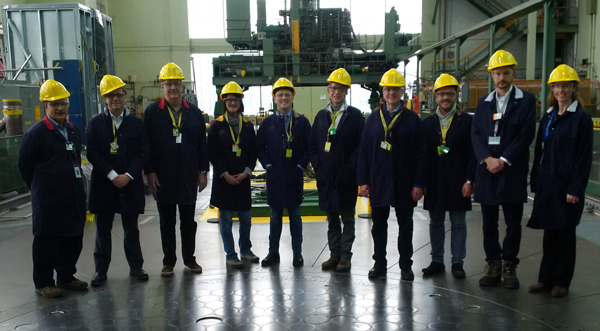
Laboratories Canada visited Chalk River’s facility run by Atomic Energy of Canada Limited (AECL)
Information Management / Information Technology (IM/IT)
IM/IT is one of the four strategic pillars of Laboratories Canada’s LTVP. Science hubs will be supported with up-to-date IM/IT systems, which meet their evolving needs for a modern and secure IT infrastructure. An enterprise approach will provide consistency and efficiency to support science business requirements, including collaboration and the agile adoption of new technologies.
Laboratories Canada has established a community of interest for collaborative discussions, funded innovative initiatives, and in collaboration with SSC, is developing a strategic vision for science IM/IT as well as enterprise IT solutions. As a key delivery partner, SSC is also working with Laboratories Canada in the planning and delivery of IT for Phase 1 science hub projects.
Community and Collaboration
The Laboratories Canada Information and Innovation Community (LCIIC) was established to provide a forum in which members fromacross the Government of Canada (GC) can share innovative ideas and solutions, consult each other on challenging issues, and collaborate in non-traditional departmental partnerships.
IT Planning and Delivery for Science Hub Projects
SSC and Laboratories Canada will develop and deliver IM/IT for the 5 science hubs in Phase 1 of this initiative through an integrated delivery model which capitalizes on the key contributions of both partners. SSC has created the SSC Science Program in order to address the horizontal shared technology needs of federal science; including for these 5 science hubs. SSC also has the mandated responsibility for government-wide cyber-security infrastructure.
Extensive consultation with the federal science community, which has already provided solid high level science business requirements, will continue including via the science hub IM/IT working groups as well as broader collaborative forums addressing the IM/IT needs of federal science. As the department responsible for Digital Government, SSC is being engaged in a partnership model at the front end of functional programming to ensure critical IM/IT requirements are integrated into foundational design considerations.
Experimentation and Innovation
An Experimentation and Innovation Fund (EIF) was created to promote innovation and experimentation with emphasis on collaboration in the community with three pilots now underway:
- A Biological Threat Analytics Platform
- Enhanced Use of Scientific Instrumentation
- Agile High-Performance Computing in the Cloud
The EIF was conceived in partnership with federal partners as a mechanism to launch a series of pilot projects that would outline opportunities, develop best practices, and address barriers inherent to long-standing and traditional processes of the Government of Canada. The intent is for Laboratories Canada to fund multi-disciplinary proposals across departments & agencies that leverage existing expertise and experience and launch a series of experimental pilot projects to unpack barriers and develop best practices in areas such as equipment sharing, IM/IT and other enabling functions that are key to operating within the new laboratory buildings that will be designed and constructed as part of the Laboratories Canada strategy.
Equipment
Access to modern scientific equipment is essential for federal scientists to effectively support their departmental/agency mandates, collaborate with partners, and perform at the highest levels of scientific excellence.
Laboratories Canada is developing a series of strategic objectives aimed at providing federal scientists with access to, and lifecycle management of, modern scientific equipment. These strategies will enhance equipment sharing and collaboration, optimize investments in scientific equipment, establish a federal scientific equipment inventory system, and support the laboratory design and construction processes for a successful transition into new facilities.
Figure 8: Diagrammatic representation of the Laboratories Canada Equipment Strategy.
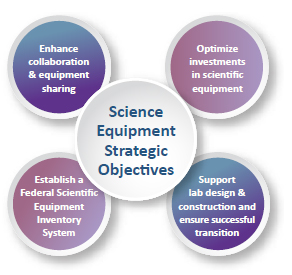
The following are some of the key activities completed in support of the development of the Equipment Strategy:
- Scientific Equipment Procurement: A National Master Supply Arrangement was launched in April 2020 to simplify and expedite the procurement of scientific equipment, parts and accessories, supplies and services for federal departments.
- Canada Foundation for Innovation (CFI) Research Facilities Navigator: Collaborative efforts were made with the Canada Foundation for Innovation (CFI) to leverage its Navigator platform for federal laboratories and equipment to promote awareness and sharing of scientific equipment across government and with academia.
The current federal listings include more than 70 research facilities and more than 570 pieces of equipment. The listings are included in www. science.gc.ca under Research Centre facilities with links to the CFI Research Navigator. - Equipment inventorying: A master equipment inventorying template has been developed to inventory federal scientific equipment. This work will be incorporated into the functional programming process.
- Guide to the Management of Scientific Equipment: A guide, developed in partnership with the Treasury Board Secretariat (TBS) and science partners has been developed to provide standardized approaches and describe the key steps in the scientific equipment lifecycle management from procurement to disposal.
Engagement and Change Management
Laboratories Canada leverages a collaborative framework to ensure that each element undertaken to implement the Laboratories Canada strategy is built in partnership and engagement with each other. This includes elements like site selection, functional programming, and reducing barriers to collaboration, including the development of workplans, deliverables and project timelines.
This Framework provides a general context and guidelines for change management throughout the lifespan of Laboratories Canada and provides the overall guiding practices and service model of change management.
Given the complexity of the transformation driven by Laboratories Canada, change management has been identified as critical to delivering the LTVP. Laboratories Canada has established a Change Management Centre of Expertise (CoE) within the LCO that will act as the link to bridge information gathered from one phase to another over the life of the program. The framework will move forward through the gradual articulation of these future states within each phase, until an envisioned end-state is developed of Laboratories Canada. This final end state will grow clearer as time goes on and more and more information from each phase feeds into it.
The federal government will evolve from the current way federal laboratories are designed and managed and build on a growing culture of experimentation and innovation in the public service. Laboratories Canada has a wide array of impacts that will affect how science is conducted. These impacts will affect the people behind science as novel approaches will be brought to the management of real property, IT, collaboration and science program delivery.
To ensure that the people behind the science are able to embrace these changes and maximize their impact, Laboratories Canada has developed a series of playbooks that provide more detailed context, guidance and tools adapted to meet the objectives of each phase and the needs of stakeholders to enable change. These documents will reflect the leadership and engagement of the science community to build a common understanding of needs and opportunities to successfully design and implement these novel approaches. They will also include the development and delivery of tools, strategies and appropriate training and communications products to facilitate the transition across departments, and evolve to reflect best practices and lessons learned throughout the strategy.
Figure 9: Diagrammatic representation of how federal science will progress through gradual articulations from its current state to the desired envisioned end state.
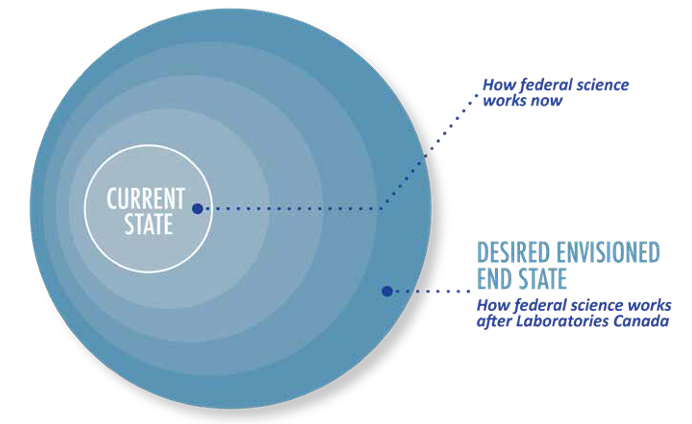
The Change Management CoE will also provide SBDAs that make up the science hubs with change management resources to support the development of science hub-specific change management strategies and delivery.
Lessons Learned – Horizontal Collaboration and Economic Revitalization
Laboratories Canada has sought opportunities to understand how regional innovations are leveraged to enhance national economic revitalization through visits to the National Institute of Advanced Industrial Science and Technology (AIST) and RIKEN in Japan. Both organizations clearly represented centralized hubs that had the ability to significantly break down barriers and work together towards a common goal. AIST is one of the largest public research organizations in Japan that is focused on the creation and practical realization of technologies useful to industry and society, and on “bridging” the gap between innovative technological seeds and commercialization. AIST is organized into 5 departments and 2 centers that bring together core technologies to exert its comprehensive strength.
RIKEN is Japan’s largest comprehensive research institution renowned for high-quality research in a diverse range of scientific disciplines and encompasses a network of world-class research centers and institutes across Japan employing approximately 3,000 scientists. Since its foundation, RIKEN has fostered pioneering, innovative research in fields spanning the entire range of the natural sciences, from developmental biology and neuroscience to quantum physics and computer science.
Supporting the Government of Canada COVID-19 Relief Initiatives
Throughout the COVID-19 pandemic, Laboratories Canada was a key player in providing important support to the Government of Canada’s relief efforts. Laboratories Canada worked with the National Microbiology Laboratory in Winnipeg, MB, the National Research Council (NRC) of Canada’s Biologics Manufacturing Centre project in Montreal, QC and in collaboration with Health Canada (HC) and Office of the Chief of Human Resources Office (OCHRO) to develop two tip sheets entitled “Preparing for Easing Restrictions in Federal Laboratories” and Workplaces Outside of Federal Government Facilities. These tip sheets will guide the return to work after the first wave of COVID-19.
Laboratories Canada also collaborated with the Office of the Chief Science Officer at the Public Health Agency of Canada (PHAC) in the procurement of necessary equipment, materials, and reagents used for virus research at the National Microbiology Laboratory in Winnipeg, MB, and in provincial laboratories in Ontario and Quebec.
Benefits to Canadians
Beyond strengthening science decision making and outcomes for Canada’s science community, Laboratories Canada has a broad range of benefits for people across Canada.
Jobs and Skills Development – An interconnected science ecosystem drives innovation and creates new jobs and skills that grow research and development capacity in the science community. Phase 1 investments will create an estimated 20,000 direct jobs in architecture, engineering, manufacturing, trades and the construction sectors, both within the NCR and across Canada.
Visible Tangible Investments – Several facilities are expected to be in full operation within a 3-4 year timeframe, stimulating the economy through investments into traditional sectors in Canada, including forestry, mining and aquatic resources.
Efficient Government – Laboratories Canada is being delivered in tight alignment with the Government’s Horizontal Fixed Asset (FAR) review, which will improve the management of fixed assets across government and better align the Government’s footprint with its program requirements.
Accessibility – Aligned with the Accessible Canada Act, Laboratories Canada is committed to accessibility while advancing federal science and technology. New collaboration centers are ideal for accessible design and will lead by example to create an accessible and inclusive workplace. The built environment offers the chance to show concrete results in accessibility, while the procurement and IT could showcase important progress, as well.
Sustainability – Laboratories Canada is committed to demonstrate leadership in low-carbon, resilient, and green operations, with new facilities designed to meet federal standards for environmental sustainability. Our facilities will be environmentally sustainable, accessible and carbon-neutral.
Broad Procurement Benefits – Construction management firms will be awarded large contracts. However, 90% of their value will be sub-contracted out to small and medium enterprises from across the country.
Reduced Costs – Instead of spending on rusted-out facilities, Laboratories Canada aims to reduce operating and maintenance costs, replacing them with spaces that better support the important work undertaken within them. These investments will reduce also health and safety risks.
Lower Risk Overall – Laboratories Canada is a once-in-a-generation opportunity to lower risk on federal science infrastructure and accomplish a broad array of objectives rooted in strengthening and modernizing Canada’s approach to federal science. It positions Canada for international leadership in areas critical for the public good and stewardship as well as broader economic objectives.
Science Collaboration – Laboratories Canada will continue to collaborate with other SBDAs to deliver scientific advancements
The Science Hubs
Atlantic Science Enterprise Centre (ASEC) hub
The Department of Fisheries and Oceans (DFO), Environment and Climate Change Canada (ECCC), the National Research Council (NRC) of Canada, the Canadian Food Inspection Agency (CFIA) and the Canadian Space Agency (CSA) compose the ASEC hub.
In 2017, the Minister of Fisheries, Oceans and the Canadian Coast Guard, announced the creation of the ASEC at the existing Gulf Fisheries Centre located in Moncton, NB. In August 2019, the Government of Canada further announced its commitment to renew the ASEC.
As a multidisciplinary research institute, the ASEC hub will be focussed on providing science-based solutions that conserve and protect Canada’s coastal ecosystems and environments. The ASEC hub will bring together multi-departmental research activities under one roof, make aquatic science more accessible, promote ocean and freshwater literacy, promote community engagement and help train the next generation of science, technology, engineering, and mathematics (STEM) researchers.
The economies of Canada’s Atlantic coastal communities rely in great part on its waters for supporting a growing finfish and shellfish aquaculture industry, the harvest of wild lobster, crab, and other species, recreational fishing such as salmon, and tourism for its spectacular coastal views and recreational activities. Fish processing and marine transport are other important maritime industries, while harvesting and processing of forest products and minerals are key sectors dependent on the management and availability of natural resources. Understanding and predicting healthy ecosystem functioning, particularly in times of global change, is critical to maintain the future sustainability of these systems and the communities they support.
Extensive consultation with the federal science community, which has already provided solid high level science business requirements, will continue including via the science hub IM/IT working groups, as well as broader collaborative forums addressing the IM/IT needs of federal science.
The official announcement of the ASEC in August 2019 was met with enthusiasm from all Ministers involved with the project:
“Today’s announcement demonstrates that the government is committed to renewing our science and research infrastructure, which will lead to job creation and local economic growth. The renewed the ASEC facility will be key to developing research with regard to Canada’s fresh and saltwater ecosystems and the scientists working at this facility will now have the tools, adaptable information technology and collaborative spaces they need to continue the important work they do on behalf of Canadians.”
— The Honourable Ginette Petitpas Taylor, Minister of Health
“The Government knows that scientists play an important role in the decisions we make, to the benefit of all Canadians. I look forward to seeing the transformation of this historic building, which will allow the ASEC to grow into a truly world-class research centre.”
— The Honourable Dominic LeBlanc. Minister of Intergovernmental and Northern Affairs and Internal Trade
Focus
- Understanding and protecting health, Atlantic ecosystems and the sustainable use of resources in the Gulf of the St. Lawrence and Atlantic Ocean regions
Science priorities
- Improve our ability to monitor, understand and predict the impacts of climate change and other threats
- Build more effective and integrated regulatory programs to protect health and aquatic ecosystems
Partners
- Fisheries and Oceans Canada
- Environment and Climate Change Canada
- National Research Council of Canada
- Canadian Food Inspection Agency
- Canadian Space Agency
The ASEC will be located on the same site at the Crown-owned Gulf Fisheries Centre (GFC), a culturally significant heritage building. The site currently houses one of the Government of Canada’s three genomic and diagnostic laboratories specializing in the health of aquatic animals, making it an ideal regional location to augment the use of genomics to understand how ocean and freshwater ecosystems and biodiversity are changing.
As a result of integrated operations at the facility, the ASEC will provide enhanced federal scientific capabilities through greater connectivity, increased equipment sharing in modern laboratories, and increased interaction between various scientific disciplines. A high-capacity IM/IT backbone will enable the sharing of invaluable data generated within the ASEC hub, and with partners, nationally and internationally. Through the development and management of a modern and forward-looking IM/IT infrastructure, a strong foundation will be in place for integrated data management and the exploitation of High Performance Computing (HPC) for analytics and visualization to bolster the use of big data, machine learning and artificial intelligence (AI) to inform decision making and create efficiencies in day-to-day operational science.
Gulf Fisheries Centre (GFC)
The GFC is a recognized heritage asset with its key historic features being its simple and unembellished design characterised by “the elongated five-storey rectangular shape, modestly projecting frontispiece, projecting wings and a flat roof” by Federal Heritage Buildings Review Office (FHBRO) Heritage Character Statement. The FHBRO report also notes the character-defining elements of the asset and its importance as the first post-secondary institution for Acadian women within their own cultural context.
Collaborations and Partnerships
As a science institute with a multidisciplinary research focussed on coastal ecosystems and environments, the ASEC will provide a nexus for advancing science in these areas.
External partnerships will be key to delivering on the transformative nature of the science. The ASEC will be a space for and a model of collaboration that will foster interdisciplinary efforts to answer scientific questions. This will be achieved by creating a space that will welcome and facilitate both on-site and virtual interactions and partnerships.
In turn, non-federal collaborators will benefit by having access to expertise, capacity and infrastructure of the federal government in the ASEC. Extensive engagement occurred with potential external partners in 2017 and 2018. The potential for strong partnerships with the ASEC was highly endorsed:
“The notion of having an innovative centre, with a number of federal science programs with field collection programs and diagnostic laboratories collocated in a modern and world-class science institute, with a mandate to collaborate externally was strongly supported by all potential partner groups. Given Moncton’s central location to other parts of the Maritime Provinces, they see it as a good place to invest in high-cost specialized equipment that could be shared with other researchers. The awareness that the Moncton-based federal science programs are all bilingual added to the attractiveness of the ASEC concept.
Universally, potential partners wanted to have more and easier collaboration with the federal government through the ASEC. The desire to have scientific exchange programs, with visiting scientists and students, working for a period of time in the Centre was seen as a necessary function of such a Centre. Indigenous communities and provinces recognized the potential to have this collaborative science centre provide experiential learning in the biological and physical sciences to youth and young scientists. In fact, they considered this an important role for the federal government in sustaining future community resilience and retaining youth.”
(from the ASEC – Summary Report on the Engagement of Potential Federal and External Partners and Collaborators in 2017 and 2018)
The integration of federal science departments and agencies into one modern facility and developing external science collaborations will create a critical concentration of expertise and knowledge to enhance synergies and efficiencies in the scientific endeavours by those who play a role in understanding, conserving and regulating activities within fresh and marine environments of the Atlantic coastal regions. The ASEC hub and partners have the potential to assist coastal Canada to understand, adapt to and be resilient in a changing world. Continued discussion and engagement of academia, Indigenous groups, provinces, the private sector, and non-governmental organisations will continue to shape the identification and implementation of future science opportunities.
Educating, Explaining and Influencing
Science Outreach
The ASEC as it currently exists within the DFO GFC has already launched a small science outreach program focussed on explaining aquatic ecosystems to middle school students, and hosting annual public lectures to talk about topical science to the general public. Looking to the future, science interpretive space would be incorporated into the facility to support delivery of activities aimed at increasing public understanding of federal regulatory science, facilitating Indigenous involvement in science, and attracting the next generation into careers in science, technology, engineering and math (STEM). The space would be used for public lectures, interpretive materials and programming to expose diverse youth to science, with programming offered in partnership with others. The spaces would also facilitate training and workshops for the federal science community. The ASEC would also actively target incorporating science outreach activities into most of its science programming by sponsoring post-doctoral fellows, hiring, and encouraging to participate in projects.
Cultural Heritage Science (CHS) hub
Cultural Heritage Science (CHS) hub is an interdisciplinary research domain spanning the sciences and humanities. It focuses on enhancing the understanding, care, use and management of both tangible and intangible cultural heritage so it can enrich people’s lives, both today and in the future.
The CHS will constitute the largest centre of expertise in cultural heritage science in Canada and will lead innovation in cultural heritage conservation nationally and internationally. This centre will bring together researchers, technicians, conservators and archaeologists from the Canadian Conservation Institute/Canadian Heritage Information Network (CCI-CHIN) and Parks Canada Agency (PCA) to create a critical mass of cultural heritage conservation science laboratories and heritage professionals in Canada. Through collaboration and partnerships with academia and the cultural heritage community including Indigenous organizations, and enhanced by the co-location of worksites, the science hub will generate innovative cultural heritage science research, practice, and promotion, and provide, for the current and next generations of cultural heritage, to ensure the preservation of Canada’s cultural heritage for present and future Canadians.
Focus
- Preserving Canada’s cultural heritage for the benefit of current and future generations
Science priorities
- Facilitate access to collections
- Identify and address emerging risks to cultural heritage
Partners
- Canadian Heritage
- Parks Canada
Parks Canada and Canadian Heritage Cultural Heritage Scientists
For the benefit of Canadians, Parks Canada’s cultural heritage scientists focus almost exclusively on applied science to better present, conserve and manage cultural heritage collections (31,000,000 objects) and cultural heritage places (11,000) that are under the custodial responsibility of Parks Canada. These places include 171 national historic sites, 46 national parks, and 5 national marine conservation areas located from coast to coast to coast and represent over 11,000 years of human activity. The Agency’s cultural heritage science functions include conservation, preventive conservation, and conservation science and archaeology laboratories.
The Canadian Conservation Institute/Canadian Heritage Information Network (CCI-CHIN) of the Department of Canadian Heritage works to advance and promote the conservation of Canada’s heritage by working with Canada’s museums, libraries and archives as well as other heritage institutions and professionals to ensure that their heritage collections are preserved. This involves not only conservation treatment, preventive conservation, and material analysis but also training and dissemination of tools and research both nationally and internationally. CCI-CHIN also works to advance the state of cultural heritage information management and technology to further the organization, management and access to museological collections.
The Integration of Indigenous Perspectives
Parks Canada works with more than 300 Indigenous communities and is working to develop collection care and handling methodologies that satisfy the interests of both western science and Indigenous knowledge perspectives. CCI-CHIN have created an Indigenous collections conservation position and are also working towards Indigenous nomenclatures. Each institution aims to advance Indigenous participation and integrate Indigenous perspectives into cultural heritage science and views it as critically important to the cultural heritage science field.
Extensive consultation with the federal science community, which has already provided solid high level science business requirements, will continue including via the science hub IM/IT working groups as well as broader collaborative forums addressing the IM/IT needs of federal science.
Figure 10: Diagrammatic representation of the CHS hub science disciplines and focus of collaborations and partnerships.

The CHS hub presents an opportunity to bring together cultural heritage science expertise at the federal level within a collaboratively-focused science hub thereby accelerating the development of new knowledge to catalyze innovation and the application of new concepts, methodologies and technologies. While the heritage conservation field has its roots in traditional practices, it has evolved into a highly technical field with conservators working closely with chemists, biologists, and engineers. The CHS hub will focus on disciplines that are critical to the conservation of cultural heritage collections and places. These disciplines include conservation science, conservation treatment, preventive conservation, archaeology, built heritage conservation, collections management, and heritage information organization and management. These disciplines share the goal of extending the life of cultural property and improving understanding of its material properties and its cultural meanings. Each discipline is rooted in the scientific method, research (including applied research), and practice. The generation of results is dependent on scientific equipment, information technology and information management.
Future phases of the CHS hub will provide a dynamic foundation to better nurture a conservation ecosystem that encompasses partners in the NCA, including Canada’s national museums, Library and Archives Canada, the Centre de conservation du Québec, scientific partners like Canadian Light Source, as well as historic places, memory institutions and universities. In addition, the CHS hub will be in a unique position to work in close collaboration with Indigenous communities to help integrate traditional approaches, skills and knowledge with existing approaches when dealing with Indigenous objects and collections. International research partnerships will also continue to contribute significantly to the Canadian cultural heritage science agenda. CHS hub will welcome visiting scientists and conservators, as well as being a focal point for public engagement in cultural heritage science.
Regulatory and Security Science (RSS) hub
The Regulatory and Security Science (RSS) hub will provide seamless integration of complementary government science capabilities to protect Canada’s people, animals and plants and advance innovation and economic growth. It will advance the government’s ability to: mitigate and respond to threats, strengthen border security, enhance the efficiency and effectiveness of international trade; and increase regulatory-innovation cohesion. RSS will encompass collaboration between multiple SBDAs such as Agriculture and Agri-Food Canada, Canadian Border Services Agency, Canadian Food Inspection Agency, Health Canada, the National Research Council of Canada, and the Public Health Agency of Canada.
The RSS hub enhances the security and protection of our borders against biological and chemical threats as well as ensures a favourable sanitary and phytosanitary environment in order for Canadian exports to grow. The overall vision is to provide seamless integration of complementary government science capabilities through targeted program actions in order to meet the challenges of the 21st century. This will be achieved by leveraging the following capabilities:
- Collaboration and integration with external science actors, engagement with federal, provincial and territorial (FPT), academic, industry, Indigenous, and international partners in order to strengthen Canadian science excellence.
- Multidisciplinary talent and the next generation of science leaders will be attracted to government and ultimately foster a more diversified workforce.
- Canadian expertise as a key junction in large-scale international science networks thereby contributing to a global regulatory standard-setting.
Focus
- Strengthening scientific collaboration between regulatory and security science providers and users to anticipate and address emerging threats
Science priorities
- Reduce vulnerabilities including protecting food safety, and animal and plant health
- Strengthen emergency preparedness and border security
- Increase economic growth and international trade
- Enhance innovation and regulatory cohesion
Partners
- Agriculture and Agri-Food Canada
- Canada Border Services Agency
- Canadian Food Inspection Agency
- Health Canada
- National Research Council of Canada
- Public Health Agency of Canada
Scientific areas within the proposed RSS hub comprise multidisciplinary expertise from different sectors, including scientific collaboration outside of the strictly regulatory environment but within the federal government to access some highly specialized areas that must be supported by government. While some expertise does reside outside of the federal government, as it is not mandate-driven, it is not always readily available when urgently required. A convergence of expertise from a diverse range of intramural sectors and disciplines is needed to maximize the potential of these opportunities – thus a campus-style science hub of laboratories with sophisticated operational capabilities spanning the continuum of activities from the frontlines to the service and research laboratories will significantly enhance the Government’s ability to support evidence- based decision-making and operational action.
Figure 11: Diagrammatic representation of the RSS hub themes showing major outcomes at the intersectoral and multidisciplinary intersection.

These programs and specialized areas of the RSS hub are grouped under three themes:
- Human Health, Safety and Protection
- Security Science
- Resource Protection and Economic Growth
RSS will enable collaboration through co-location of multiple SBDAs and linkages with the broader national science ecosystem. It will establish new and improve on existing research partnerships with the provinces and the academic sector, to further strengthen science outcomes. It will support evidence-based decision making and regulatory management through the coordination of highly specialized scientific activities, such as diagnostics and research requiring biocontainment level 3 laboratories, and secure forensic laboratories that ensure the authenticity, integrity, and protection of high-risk government science programs.
Assembling and coordinating the key science programs from the RSS hub partners will strategically allow departments to leverage each other’s strengths and resources, along with leveraging interdepartmental scientific linkages and science support systems.
Greater connectivity, increased equipment and data sharing, and reduced duplication as a result of collaboration between RSS hub partners have the potential to result in enhanced scientific capabilities. Modern facilities with a high-capacity IM/IT backbone will further enable sharing and analyses of invaluable and increasingly larger data generated by scientists from within the science hub and across Canada. Leveraging a layered, experience driven approach, data integration paired with both existing and novel opportunities to exploit High Performance Computing (HPC) for analytics and visualization will bolster the ability to use big data, machine learning and artificial intelligence (AI) to facilitate risk analysis, quick decision-making, create efficiencies in day-to-day operational science, as well as ensure business continuity.
Academia will be able to leverage modern world-class science facilities enabled by high-capacity IM/IT. The hub will also provide opportunities for science training, research collaboration and shared specialized equipment with academia. RSS will be a science hub for joint academic appointments and academic rotations to further develop the next generation of scientists. Joint research projects will accelerate transformative scientific breakthroughs for public good, and collaboration focused on multidisciplinary perspectives will lead to forward thinking policies to address major science challenges now and in the future. It will feature specialized laboratory spaces for equipment and knowledge sharing and will provide ready access to specialized expertise and surge capacity for partners where feasible. The RSS hub will also support the scientific and technical training of highly qualified personnel in high-risk scientific work.
The RSS hub facilities
The science conducted by partners of the science hub will be national in scope and internationally recognized. The core of the RSS hub will consist of one or more sites with multi-partner centres of expertise supported by regional nodes, such as the quarantine facilities at the Sidney Centre for Plant Health (CPH) in British Columbia and sites in the NCA, that will work seamlessly to expand collaboration opportunities for federal and non-federal scientists.
- NCA sites, Ottawa, ON: Science research will focus on microbial and chemical food safety, food quality and human health, and food innovation under the human health, safety and protection theme. The RSS centre will create a vibrant science hub for food research with local academia, federal laboratories, provincial partners, industry and local municipality engaged in various aspects of the farm to fork continuum. Programs under chemical food safety refer to the CFIA programs which will be in the NCA.
- Guelph, ON: Science research will focus on microbial food safety, food quality and human health, and food innovation under the human health, safety and protection theme. The RSS centre will leverage Guelph’s already vibrant science hub for food research with local academia, federal laboratories, provincial partners, industry and local municipality engaged in various aspects of the farm to fork continuum. It is also home to the Ontario Agri-Food Innovation Alliance and the Centre for Public Health and Zoonoses – key Canadian research organizations in the field of food health and nutritional science.
- Sidney, BC: Sidney Centre for Plant Health is Canada’s only post-entry quarantine location for all fruit-bearing trees, grapevines and small fruit. Researchers will focus on preventing the introduction and spread of plant virus diseases and acts as an important and strategic mechanism for the safe introduction of foreign plant material into Canada.
Leveraging regional nodes with a critical mass of federal scientists will allow Canada to strengthen its innovation capabilities and foster increased science synergies with the existing complement of expertise found in the area. This model will ensure linkages to regional areas of scientific strength are used and grown. In addition, the RSS hub will build upon its wide partner base comprising of academia, provincial and industry players and create new strategic partnerships with both national and international organizations and networks to fully leverage best available science competencies.
Sidney Centre for Plant Health (CPH) in, BC
In 2018, the Minister of Agriculture and Agri-Food announced the reinvestment to modernize the Sidney Centre for Plant Health (CPH) located on Vancouver Island, BC. The Centre was established in 1912 as a plant quarantine site to help prevent possible infection, diseases and virus. It became the only post-entry plant quarantine program in Canada and plays an integral part in Canada’s national plant health program. The Centre is recognized internationally for its expertise in post-entry quarantine and provides the scientific knowledge to inform a regulatory and risk based approach to keep Canada’s plants, animals and food safe. In association with Laboratories Canada the new facility will become an innovation science hub supporting partnerships to pursue genomics research through modern approaches to DNA sequencing. This includes the Sidney CPH program focusing on monitoring, detecting, and characterizing viruses and other pathogens infecting tree fruit, small fruit, and grapevines. The modernized facility will build on existing partnerships and synergies with academia and industry to increase the impact of plant science research across the different sectors.
TerraCanada science hub
The TerraCanada science hub will bring federal scientists together to enable shared research agendas and infrastructure to solve challenges related to: sustainable land and resource development, a low carbon economy, and the health and safety of Canadians. Five federal SBDAs, including the National Research Council of Canada (NRC), Natural Resources Canada (NRCan), Environment and Climate Change Canada (ECCC), Health Canada (HC), and the Canadian Nuclear Safety Commission (CNSC) will converge under the TerraCanada science hub to jointly experiment, discover, and develop scientific knowledge and solutions.
TerraCanada science hub will energize collaboration by establishing a multi-partner, hub and spoke network of facilities, with infrastructure and staff in the NCA and 5 regional satellites. This network will be anchored by modern facilities that will attract and retain global talent and promote opportunities for diverse researchers and students, building the next generation of federal science leadership.
Focus
- Providing transdisciplinary research and development (R&D) and innovation solutions to challenges that matter to Canadians
Science priorities
- Sustainable Land and Resource Development: Developing the economic potential of Canada’s land and resources in a sustainable manner
- Low Carbon Economy: Supporting Canada’s transformation to a low carbon economy
- Safety and Health of Canadians: Generating and sharing knowledge to mitigate the impacts of natural and human-made hazards on the health and safety of Canadians
Partners
- Canadian Nuclear Safety Commission
- Environment and Climate Change Canada
- Health Canada
- National Research Council of Canada
- Natural Resources Canada
TerraCanada science hub is also committed to the integration of traditional knowledge into its science to support land and development planning decisions, as well as to promote job opportunities and skills development. Scientists are already engaging northern communities and Indigenous peoples in current research projects in the areas of geoscience research on resource potential and land use, permafrost and glacier research for characterizing pathways, and effects of human-made radiation in traditional foods. TerraCanada will continue to strengthen and build from these relationships, in step with other government departments and the changing needs of these communities.
Once operational, the TerraCanada science hub will enable federal science and research that spans a broad spectrum to support evidence-based policy, regulations, and standards, informing responses to opportunities and emerging priorities, and advance technology for economic growth and well-being of Canadians. Working across all the locations of the network, the science hub will result in:
- Increased collaboration amongst federal partners and other regionally located players
- Increased breadth of expertise and amassed critical capacity under key areas of research
- New transdisciplinary scientific outcomes, supported by shared access to advanced equipment and science infrastructure
- Sharing and integrating data, and scientific practices for cross-functional training and development of over-the-horizon capabilities
Areas of Science
The science hub will support broader Government of Canada priorities, such as making Canada a globally competitive leader in mining, as outlined in the Resources of the Future Economic Strategy Table and the Canadian Minerals and Metals Plan. It will accelerate the development of clean technologies for the transition to the low carbon economy and reduce greenhouse gas emissions, as outlined in the Clean Technology Economic Strategy Table, the Paris Accord, the Pan-Canadian Framework on Clean Growth and Climate Change, and Mission Innovation. It will also grow the Canadian innovation economy and research and development (R&D) skills in the resources, environmental, and health sciences to contribute to the Innovation and Skills Agenda.
TerraCanada science hub R&D will focus on three overlapping science themes, with the goal to unite diverse scientific disciplines to address complex issues and transdisciplinary R&D such as zero-footprint mining, emission-free fuels, radiation protection and advanced materials.
Figure 12: Diagrammatic representation of TerraCanada science hub’s R&D overlapping science themes.
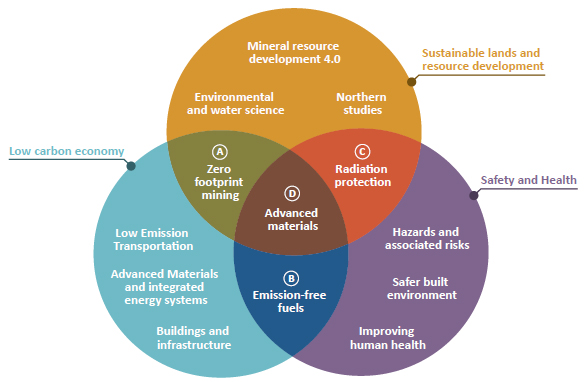
CNSC, ECCC, HC, NRC, and NRCan have come together to form the TerraCanada science hub in order to identify synergies across organizational priorities and mandates, and have defined three science themes on which they will focus:
Sustainable Land and Resource Development:
Developing the economic potential of Canada’s land and resources in a sustainable manner within the following horizontal platforms:
- Mineral Resource Development 4.0 – Process and technology development integrated with geoscience, with consideration of a circular economy, to advance Canada towards green mining.
- Environmental and Water Science – Modelling, treatment, and management technologies and sound science for environmental and water sustainability for developmental activities, especially as it pertains to extractive resources.
- Northern Studies – Integrated landmass science, northern data, and traditional knowledge to inform regional, northern, and Indigenous community decision-making.
Low Carbon Economy
Supporting Canada’s transformation to a low carbon economy within the following horizontal platforms:
- Low Emission Transportation – Technology development for carbon neutral through to zero emissions vehicles across transportation modes (air, land, water).
- Buildings and Infrastructure – Technology development to reduce carbon in buildings and infrastructure, as well as reduce energy consumption, construction and operating costs, and residual impacts on people and the environment.
- Advanced Materials and Integrated Energy Systems – Systems integration to accelerate discovery and development of clean energy materials, from laboratory to application.
Safety and Health of Canadians
Generating and sharing knowledge to mitigate the impacts of natural and human-made hazards within the following horizontal platforms:
- Hazards and Associated Risks – Identification, understanding, and responding to the chemical and physical hazards, and associated risks to Canadians.
- Safer Built Environment – Technology development and best practices to protect Canadians from natural and human-made risks by providing safer and more resilient buildings, infrastructure, and consumer products.
- Improving Human Health – Research to understand exposure and the environmental determinants of human health, and development of therapeutics or interventions to improve the health of Canadians at risk from cancer.
TerraCanada Science Hub Network
In its fully envisioned state, TerraCanada science hub will adopt a hub and spoke network of facilities, with the central hub in the NCA. The planned NCA central hub will integrate R&D, with shared research agendas and infrastructure, across all 5 partner organizations. The NCA central hub will include approximately 1,400 staff, ensuring horizontal linkages to regions where local R&D strengths and unique capabilities can be leveraged and grown.
Research under TerraCanada science hub will be conducted across six sites in Canada, each with its own scientific strength but operating as part of a unified entity.
National Capital Area (NCA)
The planned NCA location will combine multi-function capabilities from across the science hub. Research on all three science themes will be conducted for a true multidisciplinary approach.
Extensive consultation with the federal science community, which has already provided solid high level science business requirements, will continue including via the science hub IM/IT working groups as well as broader collaborative forums addressing the IM/IT needs of federal science.
Mississauga/Hamilton, ON
Southwestern Ontario is a key academic and manufacturing hub in accelerated materials discovery and clean energy solutions in support of Canada’s low carbon future. TerraCanada science hub will establish a national network at the existing NRCan facilities co-located at the McMaster University Innovation Park and the NRC Xerox Mississauga campus to develop and deploy a set of integrated technology platforms to accelerate the discovery of new materials and processes that will underpin the commercialization of new products in support of clean technologies. Through collaborative research with academia and industry in shared facilities, TerraCanada science hub will better position federal science to accelerate materials discovery to advance Canada’s commitment to clean energy and climate change mitigation. By leveraging existing partnerships and co-locating with academia and industry, the regional facility will foster a highly collaborative research environment, attract a talent pool and investors, shortening the timelines to commercialize new materials.
Sudbury, ON and Val-d’Or, QC
Federal science and technology innovation is critical to supporting the mining industry in Canada which in 2017 contributed $97 billion to Canada’s Gross Domestic Product (GDP). The mining regions of both Sudbury, ON and Val-d’Or, QC have rich geological resources and are important Canadian mining hubs, hosting some of the largest Canadian mining exploration, supply and services industries. By co-locating on site with academia and in proximity to industry and active mine sites, these two TerraCanada science hub nodes will address key mining issues and leverage the available industry knowledge and academic expertise to further the science hub vision and outcomes for green mining and sustainable development.
Quebec City, QC
Quebec City, QC is home to TerraCanada science hub’s partner NRCan Geological Survey of Canada (GSC) environmental and groundwater geoscience research. The facility will build on a productive thirty-one year collaboration with the Centre geoscientifique de Quebec (CGQ), part of the Institut National de Recherche Scientifique (INRS). INRS is a graduate research institute composed of four research and teaching centers located in different cities (Montréal, Laval, Varennes and Quebec) and plays a key role in the advancement of scientific knowledge and the training of highly qualified talent within the province. Its strong earth and environmental health network collaborates with industry and academia across Quebec and throughout Canada. Through expansion of its co-located presence within the INRS facilities, TerraCanada science hub will strengthen and expand existing academic and industry research networks in the fields of Northern climate studies and tracing environmental contaminants through the resource development cycle.
Collaboration and Engagement
The 5 inaugural partner organizations represent the current incarnation of the TerraCanada science hub under Phase 1 of the Laboratories Canada LTVP. It will address the most pressing real property issues in the NCA, while focusing on enhancing scientific excellence, establishing a new federal culture of open science and knowledge flow, and attracting and retaining a talented diverse, and inclusive cadre of scientists, including early-career and international scientists.
Early collaboration efforts will focus on expanding existing collaborations and partnerships, in the NCA and within the regions, such as with: University of Toronto (green energy materials), University of Waterloo (additive manufacturing), Laurentian University (digital mining), Université du Québec en Abitibi-Témiscamingue (mining energy efficiencies), and many others.
Over time, it is expected that new partners and collaborators – academics, other government organizations including provinces and territories, industry, and communities – will become involved through various engagement models.
Consideration will be given to novel models of engagement, such as lab space for visiting scientists and short-term tenants, citizen science, and the addition of new federal partners under Phase II of Laboratories Canada.
In Phase 2, the TerraCanada science hub will explore pilot collaborative projects to tackle barriers before facilities are operational. TerraCanada science hub represents an evolution – a transformation that enables Canadian scientists to be more interconnected and systemic in their approach to tackling cross-disciplinary R&D challenges that affect the lives of Canadians.
Transportation Safety and Technology Science (TSTS) hub
The Transportation Safety and Technology Science (TSTS) hub will create a National Centre of Excellence in Transportation Safety that will help develop the next generation of transportation safety subject matter experts.
The Transportation Safety Board (TSB) of Canada engineering lab and the National Research Council (NRC) of Canada Aerospace Research Center’s (ARC) Structures and Materials Performance Laboratory (SMPL) form the Transportation Safety and Technology Science hub. Through collaborative use of laboratory facilities and shared expertise, as well as creating partnerships with academia and industry, the science hub will focus research to address current-day transportation safety issues, test new materials and develop technologies to mitigate future safety risks for Canadians.
The TSTS hub will position itself to represent Canada internationally to remain at the forefront of international research and regulatory science. Research will support evidence-based decision making associated with structural integrity of transportation systems (air, land & sea), safety certification, and accident investigations.
Focus
- Addressing safety issues and working to mitigate future safety risks for Canadians
Science priorities
- Reduce transportation safety risks for Canadians
- Create new technologies to improve transportation in areas such as safety certification and accident investigation for the air, marine, rail and pipeline sectors
- Enhance technologies to ensure sustainment and address vehicle life extension of transportation platforms
Partners
- Transportation Safety Board of Canada
- National Research Council of Canada
Addressing Safety Issues and Working to Mitigate Future Safety Risks for Canadians
The TSTS hub will enable the improved integration of research and modeling in support of accident investigation outcomes to:
- Advance safety science and certification rules
- Investigate transportation occurrences to determine failure modes and identify component design failures and material deficiencies
- Simulate and model operational environments to test structural integrity, identify innovative solutions for life cycle extension and cost reduction for various modes of transportation, including rail, marine and pipelines and aircraft
- Undertake research and development of new technologies in support of non-destructive inspections, recovery and extraction of electronic data (i.e., black boxes) and the performance testing of new composite materials
Lessons learned from accident investigations will inform new airworthiness and certification criteria for cost effective asset utilization and safe life extension.
Increasing Collaboration
The combined synergies between the TSB lab and the NRC-SMPL science programs will create opportunities to strengthen their independent but complementary outcomes through greater access to specialized expertise. TSB engineers technologists possess unique skills and knowledge that typically can only be gained through years of experience in failure analysis. This skill set is difficult to generate given the unique nature of the work performed by the TSB and the small size of the organization. Sharing of this knowledge with NRC-SMPL scientists through collaboration on projects will not only open the door for new research opportunities for the NRC, but it will also create a greater large knowledge base within Canada to help assure the continued maintenance and generation of such expertise for the next generation. Similarly, NRC-SMPL scientists are internationally renowned leaders in their respective fields of research. Sharing of NRC-SMPL’s advanced expertise through the TSTS hub can only enhance the future capabilities of the TSB in the field of accident investigation science.
The TSTS hub will also provide greater opportunities for strengthening and expanding the collaboration with other government and transportation industry partners by building on already established relationships to create a specialized science ecosystem. An illustration of the current and potential transportation science collaboration environment is shown in below.
Extensive consultation with the federal science community, which has already provided solid high level science business requirements, will continue including via the science hub IM/IT working groups as well as broader collaborative forums addressing the IM/IT needs of federal science.
Figure 13: Diagram representing the TSTS Hub Collaboration Ecosystem.
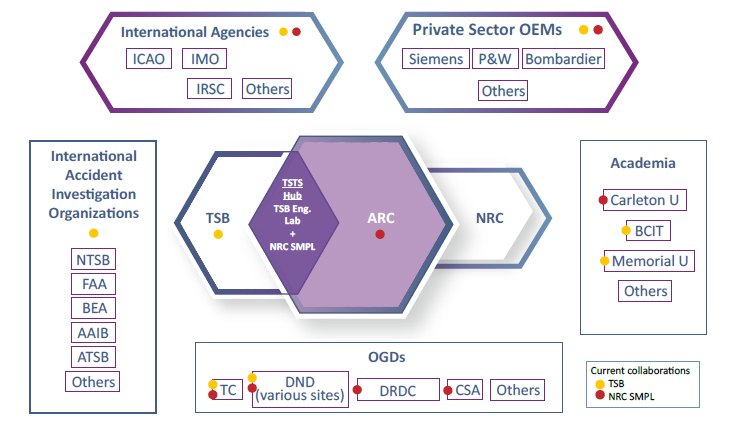
Facilities
TSB Engineering Laboratory is located at 1901 Research Private on Airport Authority crown land in Ottawa, ON and requires significant renewal and modernization to the building envelope. The NRC Aerospace Research Centre is located in several buildings on the NRC Montreal Road campus, as well as on the NRC Uplands campus in Ottawa, ON. These buildings are attached to unique experimental facilities, such as wind tunnels and jet engine test facilities. The NRC-SMPL is located in three buildings within the Montreal Road campus. A new facility is proposed to centralize activities and house the hub partners.
Much commonality already exists between the TSB and NRC-SMPL facilities with regards to science program tools, equipment, and overall infrastructure. The TSTS science hub will further advance tools by building and designing a modernized infrastructure that will allow for the centralization of activities and to house both hub partners in one facility, located in the NCA. Integrating these laboratories would not only facilitate collaboration between scientists in both organizations, but it could potentially result in better utilization rates for sophisticated and expensive equipment, while pooling of resources could open opportunities for investment in new cutting-edge analysis tools and equipment. This new collocated federal science laboratory will enable the TSTS hub to meet and surpass the challenges of the 21st century and produce positive outcomes for Canada by optimizing the use of advanced and complex scientific equipment.
Glossary of Acronyms
AADM – Associate Assistant Deputy Minister
AAFC – Agriculture and Agri-Food Canada
AAIB – Air Accident Investigation Bureau
ADM – Assistant Deputy Minister
AECL – Atomic Energy of Canada Limited
AI – Artificial Intelligence
AIST – National Institute of Advanced Industrial Science and Technology
ARC – NRC Aerospace Research Centre
ASEC – Atlantic Science Enterprise Centre
ATSB – Australian Transport Safety Bureau
BCIT – British Columbia Institute of Technology
BEA – Bureau d’Enquêtes et d’Analyses
CBSA – Canada Border Services Agency
CCI-CHIN – Canadian Conservation Institute / Canadian Heritage Information Network
CFI – Canada Foundation for Innovation
CFIA – Canadian Food Inspection Agency
CGQ – Centre géoscientifique de Québec
CHS – Cultural Heritage Science
CNL – Canadian Nuclear Laboratories
CNSC – Canadian Nuclear Safety Commission
CoE – Change Management Centre of Expertise
CPH – Sidney Centre for Plant Health
CSA – Canadian Space Agency
DFO – Department of Fisheries and Oceans
DM – Deputy Minister
DMA – Associate Deputy Minister
DMSC – Deputy Minister Science Committee
DND – Department of National Defence
DRDC – Defence Research and Development Canada
ECCC – Environment and Climate Change Canada
FAA – Federal Aviation Administration
FAR – Fixed Asset Review
FHBRO – Federal Heritage Buildings Review Office
FPT – Federal, Provincial, and Territorial
GC – Government of Canada
GDP – Gross Domestic Product
GFC – Gulf Fisheries Centre
GSC – Geological Survey of Canada
HC – Health Canada
HPC – High Performance Computing
ICAO – International Civil Aviation Organization
IM – Information Management
IMO – International Maritime Organization
IRSC – International Railway Safety Council
INRS – Institut national de la recherche scientifique
ISI – Innovation, Science and Industry
IT – Information Technology
LCO – Laboratories Canada Office
LTVP – Long Term Vision and Plan
NCA – National Capital Area
NRC – National Research Council of Canada
NRCan – Natural Resources Canada
NRC – SMPL – NRC Structures and Materials Performance Laboratory
NTSB – National Transportation Safety Board
OCHRO – Office of the Chief Human Resources Officer
PC – Parks Canada Agency
PCH – Canadian Heritage
PHAC – Public Health Agency of Canada
PSPC – Public Services and Procurement Canada
P&W – Pratt & Whitney (American Aerospace Manufacturer with Global Service Operations)
RSS – Regulatory and Security Science
R&D – Research and Development
SBDAs – Science-Based Departments and Agencies
SSC – Shared Services Canada
SSOR – Science Statement of Requirements
STEM – Science, Technology, Engineering and Mathematics
S&T – Science and Technology
TBS – Treasury Board Secretariat
TC – Transport Canada
TSB – Transportation Safety Board of Canada
TSTS – Transportation Safety and Technology Science

